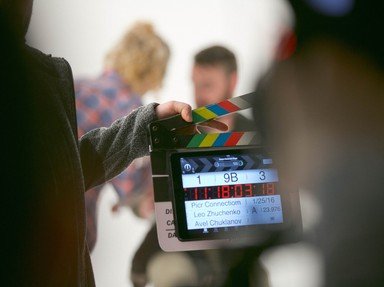Quiz Answer Key and Fun Facts
1. We open with a shot of old Father Time pondering a book -- "Three Ages". The preface tells us that the only thing that hasn't changed since time began is LOVE. We are to be shown love in three ages -- the Stone Age, the Roman Age, and the Modern Age. We start by being introduced to a Stone Age Beauty and the rivals for her affection, Buster (of course) and Wallace Beery. We first see Wallace making his entrance riding a mastodon, surrounded by his caveman entourage. How does Buster make his entrance?
2. Our Beauty has parents -- Lillian Lawrence and Big Joe Roberts -- looking out for her. They come home to the cave only to find their daughter outside, in the middle of a tug-of-war between Buster and Wallace. What does Papa Joe do to choose which man will get his daughter?
3. Having lost Round One to Wallace, Buster goes to a soothsayer to find out if the Beauty loves him or not. What method is used to determine the future?
4. Now we jump ahead a few million years to the Golden Age of Rome. Again we see the lounging Beauty. Wallace climbs aboard his chariot -- pulled by four noble horses -- amidst his guard of men. Buster emerges alone from his dwelling, and uses what form of conveyance?
5. In "The Present Age of Speed, Need, and Greed", Wallace and Buster approach Margaret's family home in their respective cars. Wallace's sleek roadster performs admirably. What goes wrong with Buster's car?
6. When Margaret's father comes home, Buster and Wallace approach him, each arguing in favor of his own suit. Papa Joe tells them, "I want you boys to know that I am master of my own home, and the choice of my daughter's husband rests entirely with --" (Margaret's mother appears and eyes him critically.) "-- my wife!" How does Mama Lillian judge her daughter's suitors?
7. In all three ages, Buster attempts to win the Beauty's attention away from Wallace by flirting with another woman to make Margaret jealous. Which is *NOT* one of the ways this plan goes wrong?
8. In each of the three ages, Buster and Wallace go man to man in a contests of worthiness. In the Stone Age, it's a duel with clubs. What is it in Roman times?
9. How do Modern Age Buster and Wallace square off to prove who is the better man?
10. When Buster bests him, Modern Age Wallace gets his revenge. How?
11. Back to the Stone Age. Just as Papa Joe is about to hand Margaret over to Wallace, Buster snatches her up and the two run away together. Buster finds a defendable position on a protected rock ledge, and he and Wallace's caveman friends engage in a rock-throwing battle. Using wits to conquer brute strength, Buster has Margaret throw rocks to keep the cavemen distracted while he sneaks around behind them and starts clubbing them. But Wallace has his own sneaky plans. How does Buster get his rival away from his girl?
12. Fast forward to the Roman Age. Wallace orders his men to kidnap Margaret. Meanwhile, Buster is left to cope with a lion, in whose lair Wallace had dumped him previously. How does Buster contend with the lion?
13. Roman Age Buster rescues Margaret and vanquishes Wallace. Fast forward to Modern Age Buster. He makes a shocking discovery about his rival: Wallace has done time for forgery -- and bigamy. Buster rushes to stop the wedding. Chased to a rooftop, Buster seems trapped. How does he escape?
14. Buster skids to a stop in front of the church and starts to go in. Then he turns around and approaches two cab drivers with a plan that we, of course, can't hear. But we see it play out a moment later. Just as the ceremony is about to start, Buster grabs Margaret by the hand and rushes her out of the church -- through one waiting taxi into another, hidden behind it. Everybody chases the first taxi, ignoring the one Buster and Margaret are in. Buster shows Margaret the proof that Wallace is a forger and a bigamist. He escorts her to her front door, but as he turns to leave, she beckons him back. He looks bewildered -- right up until she kisses him. How does he respond?
15. The next intertitle takes us back to the Stone Age, showing us in conclusion how "love has not changed" -- though, apparently, in some ways it has. In each age, we see Buster and Margaret set off from home. In the Stone Age, they're accompanied by ten children, and by five children in the Roman Age. How are they accompanied in the Modern Age?
Source: Author
ubermom
This quiz was reviewed by FunTrivia editor
jmorrow before going online.
Any errors found in FunTrivia content are routinely corrected through our feedback system.

